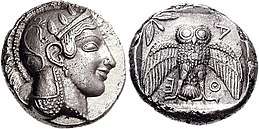History of Athens

Athens is one of the oldest named cities in the world, having been continuously inhabited for at least 5000 years.[1] Situated in southern Europe, Athens became the leading city of Ancient Greece in the first millennium BC, and its cultural achievements during the 5th century BC laid the foundations of western civilization.
During the early Middle Ages, the city experienced a decline, then recovered under the later Byzantine Empire and was relatively prosperous during the period of the Crusades (12th and 13th centuries), benefiting from Italian trade. Following a period of sharp decline under the rule of the Ottoman Empire, Athens re-emerged in the 19th century as the capital of the independent and self-governing Greek state.
| Athens Ἀθῆναι | |||||||||
|---|---|---|---|---|---|---|---|---|---|
| 900 BC – 146 BC | |||||||||
 | |||||||||
| Capital | Athens | ||||||||
| Common languages | Attic Greek | ||||||||
| Religion | Greek Polytheism | ||||||||
| Government |
Aristocracy (until 510 BC) Democracy (From 510 BC) | ||||||||
| Legislature | Ecclesia | ||||||||
• Council | Boule | ||||||||
| Historical era | Archaic/Classical | ||||||||
• Established | c.900 BC | ||||||||
| 594 BC | |||||||||
• Cleisthenes establishes democracy | 510 BC | ||||||||
| 431 BC | |||||||||
• Subjugation by Macedon | 338 BC | ||||||||
• Roman conquest of Achaea | 146 BC | ||||||||
| Currency | Drachma | ||||||||
| |||||||||
| Today part of |
| ||||||||
History
The name of Athens, connected to the name of its patron goddess Athena, originates from an earlier Pre-Greek language.[2] The etiological myth explaining how Athens acquired this name through the legendary contest between Poseidon and Athena was described by Herodotus,[3] Apollodorus,[4] Ovid, Plutarch,[5] Pausanias and others. It even became the theme of the sculpture on the West pediment of the Parthenon. Both Athena and Poseidon requested to be patrons of the city and to give their name to it, so they competed with one another for the honour, offering the city one gift each. Poseidon produced a spring by striking the ground with his trident,[6] symbolizing naval power.
Athena created the olive tree, symbolizing peace and prosperity. The Athenians, under their ruler Cecrops, accepted the olive tree and named the city after Athena. (Later the Southern Italian city of Paestum was founded under the name of Poseidonia at about 600 BC.) A sacred olive tree said to be the one created by the goddess was still kept on the Acropolis at the time of Pausanias (2nd century AD).[7] It was located by the temple of Pandrosus, next to the Parthenon. According to Herodotus, the tree had been burnt down during the Persian Wars, but a shoot sprung from the stump. The Greeks saw this as a symbol that Athena still had her mark there on the city.[3]
Plato, in his dialogue Cratylus, offers his own etymology of Athena's name connecting it to the phrase ἁ θεονόα or hē theoû nóēsis (ἡ θεοῦ νόησις, 'the mind of god').[8]
Geographical setting
_p303_ATHENS_AND_ITS_NEIGHBOURHOOD.jpg)
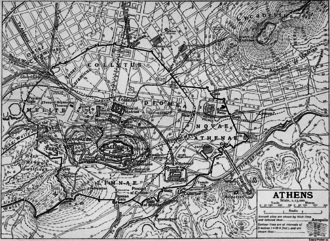
The site on which Athens stands was first inhabited in the Neolithic period, perhaps as a defensible settlement on top of the Acropolis ('high city'), around the end of the fourth millennium BC or a little later.[9] The Acropolis is a natural defensive position which commands the surrounding plains. The settlement was about 20 km (12 mi) inland from the Saronic Gulf, in the centre of the Cephisian Plain, a fertile valley surrounded by rivers. To the east lies Mount Hymettus, to the north Mount Pentelicus.
Ancient Athens, in the first millennium BC, occupied a very small area compared to the sprawling metropolis of modern Greece. The ancient walled city encompassed an area measuring about 2 km (1 mi) from east to west and slightly less than that from north to south, although at its peak the ancient city had suburbs extending well beyond these walls. The Acropolis was situated just south of the centre of this walled area.
The Agora, the commercial and social centre of the city, lay about 400 m (1,312 ft) north of the Acropolis, in what is now the Monastiraki district. The hill of the Pnyx, where the Athenian Assembly met, lay at the western end of the city. The Eridanus (Ηριδανός) river flowed through the city.
One of the most important religious sites in ancient Athens was the Temple of Athena, known today as the Parthenon, which stood on top of the Acropolis, where its evocative ruins still stand. Two other major religious sites, the Temple of Hephaestus (which is still largely intact) and the Temple of Olympian Zeus or Olympeion (once the largest temple in mainland Greece but now in ruins) also lay within the city walls.
According to Thucydides, the Athenian citizens at the beginning of the Peloponnesian War (5th century BC) numbered 40,000, making with their families a total of 140,000 people in all. The metics, i.e. those who did not have citizen rights and paid for the right to reside in Athens, numbered a further 70,000, whilst slaves were estimated at between 150,000 and 400,000.[10] Hence, approximately a tenth of the population were adult male citizens, eligible to meet and vote in the Assembly and be elected to office. After the conquests of Alexander the Great in the 4th century BC, the city's population began to decrease as Greeks migrated to the Hellenistic empires in the east.
Antiquity
Origins and early history
Athens has been inhabited from Neolithic times, possibly from the end of the 4th millennium BC, or nearly 5,000 years.[11] By 1412 BC, the settlement had become an important center of the Mycenaean civilization and the Acropolis was the site of a major Mycenaean fortress whose remains can be recognised from sections of the characteristic Cyclopean walls.[12] On the summit of the Acropolis, below the later Erechtheion, cuttings in the rock have been identified as the location of a Mycenaean palace.[12] Between 1250 and 1200 BC, to feed the needs of the Mycenaean settlement, a staircase was built down a cleft in the rock to reach a water supply that was protected by enemy incursions,[13] similarly to what was carried out at Mycenae.
Unlike other Mycenaean centers, such as Mycenae and Pylos (see Bronze Age collapse), it is unclear whether Athens suffered destruction in about 1200 BC, an event traditionally attributed to a Dorian invasion (though now commonly attributed to a systems collapse, part of the Late Bronze Age collapse), and the Athenians always maintained that they were "pure" Ionians with no Dorian element. However, Athens, like many other Bronze Age settlements, went into economic decline for around 150 years following this.
Iron Age burials, in the Kerameikos and other locations, are often richly provided for and demonstrate that from 900 BC onwards Athens was one of the leading centres of trade and prosperity in the region; as were Lefkandi in Euboea and Knossos in Crete.[14] This position may well have resulted from its central location in the Greek world, its secure stronghold on the Acropolis and its access to the sea, which gave it a natural advantage over inland rivals such as Thebes and Sparta.
According to legend, Athens was formerly ruled by kings (see Kings of Athens), a situation which may have continued up until the 9th century BC. From later accounts, it is believed that these kings stood at the head of a land-owning aristocracy known as the Eupatridae (the 'well-born'), whose instrument of government was a Council which met on the Hill of Ares, called the Areopagus and appointed the chief city officials, the archons and the polemarch (commander-in-chief).
Before the concept of the political state arose, four tribes based upon family relationships dominated the area. The members had certain rights, privileges, and obligations:
- Common religious rights.
- A common burial place.
- Mutual rights of succession to property of deceased members.
- Reciprocal obligations of help, defense and redress of injuries.
- The right to intermarry in the gens in the cases of orphan daughters and heiresses.
- The possession of common property, an archon, and a treasurer.
- The limitation of descent to the male line.
- The obligation not to marry in the gens except in specified cases.
- The right to adopt strangers into the gens.
- The right to elect and depose its chiefs.[15]
During this period, Athens succeeded in bringing the other towns of Attica under its rule. This process of synoikismos – the bringing together into one home – created the largest and wealthiest state on the Greek mainland, but it also created a larger class of people excluded from political life by the nobility. By the 7th century BC, social unrest had become widespread, and the Areopagus appointed Draco to draft a strict new code of law (hence the word 'draconian'). When this failed, they appointed Solon, with a mandate to create a new constitution (in 594 BC).
Reform and Democracy
| Didrachm of Athens, 545–510 BC | |
|---|---|
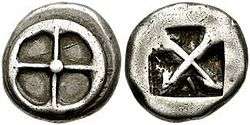 | |
| Obv: Four-spoked wheel | Rev: Incuse square, divided diagonally |
| Silver didrachm of Athens of heraldic type from the time of Peisistratus, 545–510 BC | |
| Obol of Athens, 545–525 BC | |
|---|---|
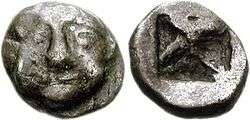 | |
| Obv: A Gorgoneion | Rev: Square incuse |
| An archaic silver obol of Athens of heraldic type from the time of Peisistratus, 545–525 BC | |
The reforms that Solon initiated dealt with both political and economic issues. The economic power of the Eupatridae was reduced by forbidding the enslavement of Athenian citizens as a punishment for debt (Debt bondage), by breaking up large landed estates and freeing up trade and commerce, which allowed the emergence of a prosperous urban trading class. Politically, Solon divided the Athenians into four classes, based on their wealth and their ability to perform military service. The poorest class, the Thetai, (Ancient Greek Θήται) who formed the majority of the population, received political rights for the first time and were able to vote in the Ecclesia (Assembly). But only the upper classes could hold political office. The Areopagus continued to exist but its powers were reduced.
The new system laid the foundations for what eventually became Athenian democracy, but in the short-term it failed to quell class conflict and after twenty years of unrest the popular party, led by Peisistratus, a cousin of Solon, seized power (in 541 BC). Peisistratus is usually called a tyrant, but the Greek word tyrannos does not mean a cruel and despotic ruler, merely one who took power by force. Peisistratus was in fact a very popular ruler, who made Athens wealthy, powerful, and a centre of culture, and instituted Athenian naval supremacy in the Aegean Sea and beyond. He preserved the Solonian Constitution, but made sure that he and his family held all the offices of state.
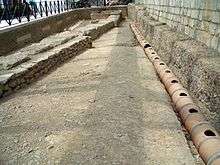
He built the first aqueduct as an underground tunnel.[16] Its sources were most likely on the slopes of Mount Hymettos and along the Ilissos river. It supplied, among other structures, the fountain house in the southeast corner of the Agora, but it had a number of branches. In the 4th century BC it was replaced by a system of terracotta pipes in a stone-built underground channel, sometimes called the Hymettos aqueduct; many sections had round, oval or square access holes on top of about 10 cm × 10 cm (4 in × 4 in). Pipe segments of this system are displayed at the Evangelismos and Syntagma Metro stations.

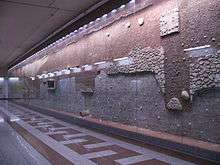
Peisistratus died in 527 BC and was succeeded by his sons Hippias and Hipparchus. They proved to be much less adept rulers and in 514 BC, Hipparchus was assassinated in a private dispute over a young man (see Harmodius and Aristogeiton). This led Hippias to establish a real dictatorship, which proved very unpopular. He was overthrown in 510 BC. A radical politician with an aristocratic background named Cleisthenes then took charge, and it was he who established democracy in Athens.
The reforms of Cleisthenes replaced the traditional four "tribes" (phyle) with ten new ones, named after legendary heroes and having no class basis; they were in fact electorates. Each 'tribe' was in turn divided into three 'trittyes' and each trittys had one or more demes, which became the basis of local government. The tribes each elected fifty members to the Boule, a council which governed Athens on a day-to-day basis. The Assembly was open to all citizens and was both a legislature and a supreme court, except in murder cases and religious matters, which became the only remaining functions of the Areopagus.
Most public offices were filled by lot, although the ten strategoi (generals) were elected. This system remained remarkably stable and, with a few brief interruptions, it remained in place for 170 years, until Philip II of Macedon defeated Athens and Thebes at the Battle of Chaeronea in 338 BC.
Classical Athens
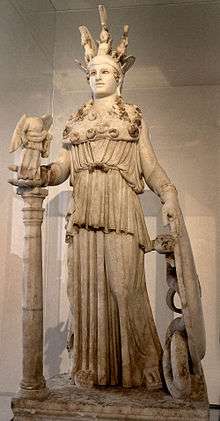
Early Athenian military history and Persian era
Prior to the rise of Athens, Sparta considered itself to be the leader of the Greeks, or hegemon. In 499 BC, Athens sent troops to aid the Ionian Greeks of Asia Minor, who were rebelling against the Persian Empire (the Ionian Revolt). This provoked two Persian invasions of Greece (see Persian Wars). In 490 BC, the Athenians, led by the soldier-statesman Miltiades, defeated the first invasion of the Persians under Darius I at the Battle of Marathon.
In 480BC, the Persians returned under Darius's son Xerxes. When a small Greek force holding the pass of Thermopylae was defeated, the Persians proceeded to capture an evacuated Athens. The city of Athens got captured and sacked twice by the Persians within one year after Thermopylae.[17] Subsequently, the Athenians (led by Themistocles), with their allies, engaged the much larger Persian navy at sea in the Battle of Salamis. Xerxes built a throne on the coast in order to watch the Greek navy being defeated, but instead, the Persians were routed. This established a great turning point in the war.
In 479 BC, the Athenians and Spartans, with their allies, defeated the Persian army at the Battle of Plataea. However, it was Athens that took the war to Asia Minor. These victories enabled it to bring most of the Aegean and many other parts of Greece together in the Delian League, an Athenian-dominated alliance.
Artists and philosophers
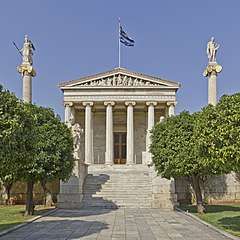
The period from the end of the Persian Wars to the Macedonian conquest marked the zenith of Athens as a center of literature, philosophy (Greek philosophy), and the arts (Greek theatre). In Athens at this time, the political satire of the Comic poets at the theatres had a remarkable influence on public opinion.[18]
Some of the most important figures of Western cultural and intellectual history lived in Athens during this period: the dramatists Aeschylus, Aristophanes, Euripides and Sophocles, the physician Hippocrates, the philosophers Aristotle, Plato and Socrates, the historians Herodotus, Thucydides and Xenophon, the poet Simonides, and the sculptor Phidias. The leading statesman of this period was Pericles, who used the tribute paid by the members of the Delian League to build the Parthenon and other great monuments of classical Athens. The city became, in Pericles's words, "the school of Hellas [Greece]."
Peloponnesian War
The resentment felt by other cities at the hegemony of Athens led to the Peloponnesian War, which began in 431 BC and pitted Athens and its increasingly rebellious overseas empire against a coalition of land-based states led by Sparta. The conflict ended with a victory for Sparta and the end of Athenian command of the sea. This civil war in Greece left the Greeks weak and divided leading to Philip II and Alexander the Great taking over Greece.
Athenian coup of 411 BC
Due to its poor handling of the war, the democracy in Athens was briefly overthrown by a coup in 411 BC, however, it was quickly restored. The Peloponnesian War ended in 404 BC with the complete defeat of Athens. Since the loss of the war was largely blamed on democratic politicians such as Cleon and Cleophon, there was a brief reaction against democracy, aided by the Spartan army (the rule of the Thirty Tyrants). In 403 BC, however, democracy was restored by Thrasybulus and an amnesty was declared.
Corinthian War and the Second Athenian League
Sparta's former allies soon turned against her, due to her imperialist policy, and soon Athens' former enemies Thebes and Corinth had become her allies; they fought with Athens and Argos against Sparta in the indecisive Corinthian War (395 – 387 BC). Opposition to Sparta enabled Athens to establish a Second Athenian League.
Finally Thebes defeated Sparta in 371 BC in the Battle of Leuctra. But then the Greek cities (including Athens and Sparta) turned against Thebes, whose dominance was stopped at the Battle of Mantinea (362 BC) with the death of its military-genius leader Epaminondas.
Athens and the rise of Macedon
By the mid-4th century BC, however, the northern Greek kingdom of Macedon was becoming dominant in Athenian affairs. In 338 BC the armies of Philip II defeated an alliance of some of the Greek city-states including Athens and Thebes at the Battle of Chaeronea, effectively limiting Athenian independence. Subsequently, the conquests of his son Alexander the Great widened Greek horizons and made the traditional Greek city state obsolete. Athens remained a wealthy city with a brilliant cultural life, but ceased to be a leading power.
Hellenistic Athens
Roman Athens

In 88–85 BC, most Athenian buildings, both houses and fortifications, were leveled by the Roman general Sulla (138 BC – 78 BC), although many civic buildings and monuments were left intact.[19] Under Rome, Athens was given the status of a free city because of its widely admired schools. The Roman emperor Hadrian, in the 2nd century AD, constructed a library, a gymnasium, an aqueduct [20] which is still in use, several temples and sanctuaries, a bridge and financed the completion of the Temple of Olympian Zeus.[21]
.jpg)
The city was sacked by the Heruli in AD 267, resulting in the burning of all the public buildings, the plundering of the lower city and the damaging of the Agora and Acropolis. After this the city to the north of the Acropolis was hastily refortified on a smaller scale, with the Agora left outside the walls. Athens remained a centre of learning and philosophy during its 500 years of Roman rule, patronized by emperors such as Nero and Hadrian.
The sack of the city by the Heruls in 267 and Alaric in 396, however, dealt a heavy blow to the city's fabric and fortunes, and Athens was henceforth confined to a small fortified area that embraced a fraction of the ancient city.[22] The city remained an important center of learning, especially of Neoplatonism—with notable pupils including Gregory of Nazianzus, Basil of Caesarea and emperor Julian—and consequently a center of paganism. Christian items do not appear in the archaeological record until the early 5th century.[22] The Emperor Justinian I closed down the city's philosophical schools in 529, an event whose impact on the city is much debated,[22] but is generally taken to mark the end of the ancient history of Athens.
Middle Ages
Byzantine Athens
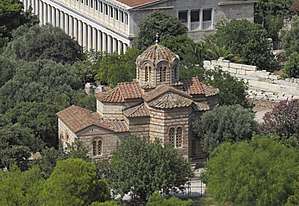
From very early on the imperial period, but accelerating in the third century AD, the centre of the Roman Empire moved towards the eastern half of the Mediterranean basin. The Empire became Christianized, and the use of Latin declined in favour of exclusive use of Greek: in the early Roman period, both languages had been used. The empire after this transition is known today as the Byzantine Empire due to its focus on the imperial capital at Constantinople, the old Greek city of Byzantion. The division is historically useful, but misleading, with an unbroken chain of emperors continuing up until the thirteenth century, and all citizens identifying themselves as fully Roman ("Rhomaioi"). The conversion of the empire from paganism to Christianity greatly affected Athens, resulting in reduced reverence for the city.[23] Ancient monuments such as the Parthenon, Erechtheion and the Hephaisteion (Theseion) were converted into churches. As the empire became increasingly anti-pagan, Athens became a provincial town and experienced fluctuating fortunes. Many of its works of art were taken by the emperors to Constantinople. Athens was sacked by the Slavs in 582, but remained in imperial hands thereafter, as highlighted by the visit of Emperor Constans II in 662/3 and its inclusion in the Theme of Hellas.[22] The city was threatened by Saracen raids in the 8th–9th centuries—in 896, Athens was raided and possibly occupied for a short period, an event which left some archaeological remains and elements of Arabic ornamentation in contemporary buildings[24]—but there is also evidence of a mosque existing in the city at the time.[22] In the great dispute over Byzantine Iconoclasm, Athens is commonly held to have supported the iconophile position, chiefly due to the role played by Empress Irene of Athens in the ending of the first period of Iconoclasm at the Second Council of Nicaea in 787.[22] A few years later, another Athenian, Theophano, became empress as the wife of Staurakios (r. 811–812).[22]
Invasion of the empire by the Turks after the Battle of Manzikert in 1071, and the ensuing civil wars, largely passed the region by and Athens continued its provincial existence unharmed. When the Byzantine Empire was rescued by the resolute leadership of the three Komnenos emperors Alexios, John and Manuel, Attica and the rest of Greece prospered. Archaeological evidence tells us that the medieval town experienced a period of rapid and sustained growth, starting in the 11th century and continuing until the end of the 12th century.
The agora or marketplace, which had been deserted since late antiquity, began to be built over, and soon the town became an important centre for the production of soaps and dyes. The growth of the town attracted the Venetians, and various other traders who frequented the ports of the Aegean, to Athens. This interest in trade appears to have further increased the economic prosperity of the town.
The 11th and 12th centuries were the Golden Age of Byzantine art in Athens. Almost all of the most important Middle Byzantine churches in and around Athens were built during these two centuries, and this reflects the growth of the town in general. However, this medieval prosperity was not to last. In 1204, the Fourth Crusade conquered Athens and the city was not recovered from the Latins before it was taken by the Ottoman Turks. It did not become Greek in government again until the 19th century.
Latin Athens
_-_Athens_-_Propylaia_1868-1875.jpg)
From 1204 until 1458, Athens was ruled by Latins in three separate periods.
Burgundian period
Athens was initially the capital of the eponymous Duchy of Athens, a fief of the Latin Empire which replaced Byzantium. After Thebes became a possession of the Latin dukes, which were of the Burgundian family called De la Roche, it replaced Athens as the capital and seat of government, although Athens remained the most influential ecclesiastical centre in the duchy and site of a prime fortress.
Under the Burgundian dukes, a bell tower was added to the Parthenon. The Burgundians brought chivalry and tournaments to Athens; they also fortified the Acropolis. They were themselves influenced by Byzantine Greek culture.
Aragonese period
In 1311, Athens was conquered by the Catalan Company, a band of mercenaries called Almogavars. It was held by the Catalans until 1388. After 1379, when Thebes was lost, Athens became the capital of the duchy again.
The history of Aragonese Athens, called Cetines (rarely Athenes) by the conquerors, is obscure. Athens was a veguería with its own castellan, captain, and veguer. At some point during the Aragonese period, the Acropolis was further fortified and the Athenian archdiocese received an extra two suffragan sees.
Florentine period
In 1388, the Florentine Nerio I Acciajuoli took the city and made himself duke. The Florentines had to dispute the city with the Republic of Venice, but they ultimately emerged victorious after seven years of Venetian rule (1395–1402). The descendants of Nerio I Acciajuoli ruled the city (as their capital) until the Turkish conquest of 1458.
Modern history
Ottoman Athens
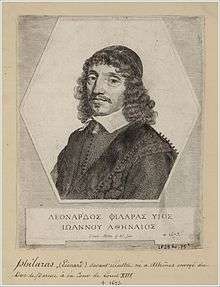
The first Ottoman attack on Athens, which involved a short-lived occupation of the town, came in 1397, under the Ottoman generals Yaqub Pasha and Timurtash.[24] Finally, in 1458, Athens was captured by the Ottomans under the personal leadership of Sultan Mehmed II.[24] As the Ottoman Sultan rode into the city, he was greatly struck by the beauty of its ancient monuments and issued a firman (imperial edict) forbidding their looting or destruction, on pain of death. The Parthenon was converted into Athens' main mosque.[23]
Under Ottoman rule, the city was denuded of any importance and its population severely declined, leaving Athens as a "small country town" (Franz Babinger).[24] From the early 17th century, Athens came under the jurisdiction of the Kizlar Agha, the chief black eunuch of the Sultans' harem. The city had originally been granted by Sultan Ahmed I (r. 1603–1617) to Basilica, one of his favourite concubines, who hailed from the city, in response of complaints of maladministration by the local governors. After her death, Athens came under the purview of the Kizlar Agha.[27]
The Turks began a practice of storing gunpowder and explosives in the Parthenon and Propylaea. In 1640, a lightning bolt struck the Propylaea, causing its destruction.[28] In 1687, during the Morean War, the Acropolis was besieged by the Venetians under Francesco Morosini, and the temple of Athena Nike was dismantled by the Ottomans to fortify the Parthenon. A shot fired during the bombardment of the Acropolis caused a powder magazine in the Parthenon to explode (26 September), and the building was severely damaged, giving it the appearance we see today. The occupation of the Acropolis continued for six months and both the Venetians and the Ottomans participated in the looting of the Parthenon. One of its western pediments was removed, causing even more damage to the structure.[23][24] The Venetians occupied the town, converting its two mosques into Catholic and Protestant churches, but on 9 April 1688 they abandoned it again to the Ottomans.[24]
In the 18th century, however, the city recovered much of its prosperity. During Michel Fourmont's visit in the city in the 1720s, he witnessed much construction going on, and by the time the Athenian teacher Ioannis Benizelos wrote an account of the city's affairs in the 1770s, Athens was once again enjoying some prosperity, so that, according to Benizelos, it "could be cited as an example to the other cities of Greece".[29] Its Greek population possessed a considerable degree of self-government, under a council of primates composed of the leading aristocratic families, along with the city's metropolitan bishop. The community was quite influential with the Ottoman authorities, the voevoda (governor), the kadi (judge), the mufti, and the garrison commander of the Acropolis—according to Benizelos, if the voevoda did not treat them well and heed their opinion, he was liable to be removed before his annual term of office was out—particularly through the influence at Constantinople of the two Athenian-born Patriarchs of Jerusalem, Parthenius (1737–1766) and Ephram II (1766–1770).[29] Taxation was also light, with only the kharaj tax payable to the Ottoman government, as well as the salt tax and a water-tax for the olive yards and gardens.[29]
This peaceful situation was interrupted in 1752–1753, when the execution of the previous Kizlar Agha resulted in the dispatch of a new voevoda, Sari Muselimi. His abuse of power led to protests by both the Greeks and the Turks; Sari Muselimi killed some of the notables who protested, whereupon the populace burned down his residence. Sari Muselimi fled to the Acropolis where he was besieged by the Athenians, until the Ottoman governor of Negroponte intervened and restored order, imprisoning the Metropolitan and imposing a heavy fine on the Greek community.[29] In 1759 the new voevoda, a native Muslim, destroyed one of the pillars of the Temple of Olympian Zeus to provide material for a fifth mosque for the city—an illegal act, as the temple was considered the Sultan's property.[29] In the next year, Athens was removed from the purview of the Kizlar Agha and transferred to the privy purse of the Sultan. Henceforth it would be leased as a malikhane, a form of tax farming where the owner bought the proceeds of the city for a fixed sum, and enjoyed them for life.[29]
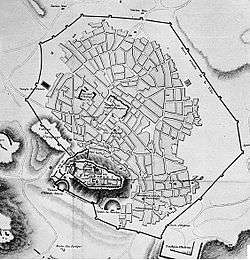
The first owner (malikhane sahib), Ismail Agha, a local Turk from Livadeia, had been humane and popular, appointing good voevodas, so that he was nicknamed "the Good".[29] English visitors during the 1760s report a population of around 10,000 inhabitants, around four fifths of which were Christians. The Turkish community numbered several families established in the city since the Ottoman conquest; and their relations with their Christian neighbours were friendlier than elsewhere, as they had assimilated themselves to a degree, even to the point of drinking wine.[29] The climate was healthy, but the city relied chiefly on pasture—practiced by the Arvanites of Attica—rather than agriculture. It exported leather, soap, grain, oil, honey, wax, resin, a little silk, cheese, and valonia, chiefly to Constantinople and France. The city hosted a French and an English consul.[29] During the Orlov Revolt the Athenians, with the exception of the younger ones, remained cautious and passive, even when the Greek chieftain Mitromaras seized Salamis. Nevertheless, it was only thanks to the intervention of Ismail Agha that the city was spared a massacre as reprisals, and was forced to pay an indemnity instead.[29]
Ismail Agha's successor, Hadji Ali Haseki was cruel and tyrannical, and the twenty years of his on-and-off rule over the city, represented one of the worst periods in the city's history. Supported by the city's aristocratic families, and his relationship with the Sultan's sister, who was his lover, he extorted large sums from the populace, and seized much property from them. Through protests in Constantinople, the Athenians achieved his recall several times, but Haseki always returned until his final downfall and execution in 1795.[29] His early tenure also saw two large Albanian raids into Attica, as a response to which he ordered the construction of a new city wall, the "Wall of Haseki", which was partly constructed with material taken from ancient monuments.[24][29] Between 1801 and 1805 Lord Elgin, the British ambassador to the Ottoman Empire, arranged for the removal of many sculptures from the Parthenon (the Elgin marbles). Along with the Panathenaic frieze, one of the six caryatids of the Erechtheion was extracted and replaced with a plaster mold. All in all, fifty pieces of sculpture were carried away, including three fragments purchased by the French.[23]
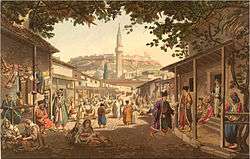
Athens produced some notable intellectuals during this era, such as Demetrius Chalcondyles (1424–1511), who became a celebrated Renaissance teacher of Greek and of Platonic philosophy in Italy.[30] Chalcondyles published the first printed editions of Homer (in 1488), of Isocrates (in 1493), and of the Suda lexicon (in 1499), and a Greek grammar (Erotemata).[31]
His cousin Laonicus Chalcondyles (c. 1423–1490) was also a native of Athens, a notable scholar and Byzantine historian and one of the most valuable of the later Greek historians. He was the author of the valuable work Historiarum Demonstrationes (Demonstrations of History) and was a great admirer of the ancient writer Herodotus, encouraging the interest of contemporary Italian humanists in that ancient historian.[32] In the 17th century, Athenian-born Leonardos Philaras (c. 1595–1673),[33] was a Greek scholar, politician, diplomat, advisor and the Duke of Parma's ambassador to the French court,[34] spending much of his career trying to persuade western European intellectuals to support Greek independence.[35][36]
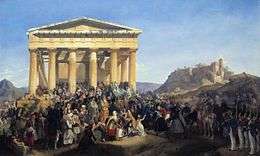
Independence from the Ottomans
In 1822, a Greek insurgency captured the city, but it fell to the Ottomans again in 1826 (though Acropolis held till June 1827). Again the ancient monuments suffered badly. The Ottoman forces remained in possession until March 1833, when they withdrew. At that time, the city (as throughout the Ottoman period) had a small population of an estimated 400 houses, mostly located around the Acropolis in the Plaka.
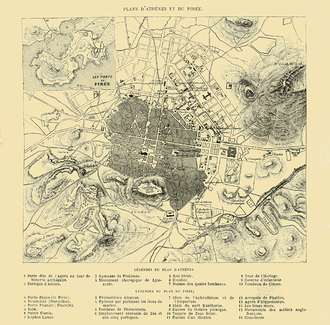
Modern Athens
In 1832, Otto, Prince of Bavaria, was proclaimed King of Greece. He adopted the Greek spelling of his name, King Othon, as well as Greek national dress, and made it one of his first tasks as king to conduct a detailed archaeological and topographical survey of Athens, his new capital. He assigned Gustav Eduard Schaubert and Stamatios Kleanthis to complete this task.[23] At that time, Athens had a population of only 4,000 to 5,000 people in a scattering of houses at the foot of the Acropolis, located in what today covers the district of Plaka.
Athens was chosen as the Greek capital for historical and sentimental reasons. There are few buildings dating from the period of the Byzantine Empire or the 18th century. Once the capital was established, a modern city plan was laid out and public buildings were erected.
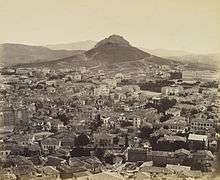
The finest legacy of this period are the buildings of the University of Athens (1837), the National Gardens of Athens (1840), the National Library of Greece (1842), the Old Royal Palace (now the Greek Parliament Building; 1843), the Old Parliament Building (1858), the City Hall (1874), the Zappeion Exhibition Hall (1878), the Greek National Academy (1885) and the New Royal Palace (now the Presidential Palace; 1897). In 1896 the city hosted the 1896 Summer Olympics.
Athens experienced its second period of explosive growth following the disastrous war with Turkey in 1921, when more than a million Greek refugees from Asia Minor were resettled in Greece. Suburbs such as Nea Ionia and Nea Smyrni began as refugee settlements on the Athens outskirts.
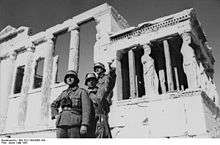
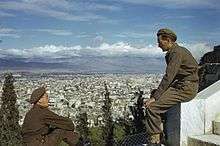
Athens during World War II
Athens was occupied by the Germans during World War II and experienced terrible privations during the later years of the war. The Great Famine (Greece) was heavy in the city. Several resistance organizations were created. After the liberation, in 1944, there was heavy fighting in the city between the communist forces and the government forces backed by the British.
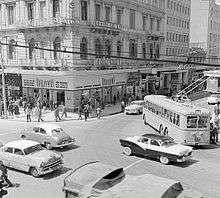
Postwar Athens
After World War II the city began to grow again as people migrated from the villages and islands to find work. Greek entry into the European Union in 1981 brought a flood of new investment to the city, but also increasing social and environmental problems. Athens had some of the worst traffic congestion and air pollution in the world at that time. This posed a new threat to the ancient monuments of Athens, as traffic vibration weakened foundations and air pollution corroded marble. The city's environmental and infrastructure problems were the main reason why Athens failed to secure the 1996 centenary Olympic Games.
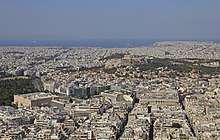
Athens today
Following the failed attempt to secure the 1996 Summer Olympics, both the city of Athens and the Greek government, aided by European Union funds, undertook major infrastructure projects such as the new Athens Airport and a new metro system. The city also tackled air pollution by restricting the use of cars in the centre of the city. As a result, Athens was awarded the 2004 Olympic Games. Despite the skepticism of many observers, the games were a great success and brought renewed international prestige (and tourism revenue) to Athens. Athens was chosen as the reference city for the 14th dokumenta major international art Event in 2017 under the title Learning from Athens.
Recent historical population
Throughout its long history, Athens has had many different population levels. The table below shows the historical population of Athens in relatively recent times.
| Year | City population | Urban population | Metro population |
|---|---|---|---|
| 1833 | 4,000[23] | – | – |
| 1870 | 44,500[23] | – | – |
| 1896 | 123,000[23] | – | |
| 1921 (Pre-Population exchange) | 473,000[23] | – | – |
| 1921 (Post-Population exchange) | 718,000[23] | – | – |
| 1971 | 867,023[37] | – | – |
| 1981 | 885,737 | – | – |
| 1991 | 772,072 | – | 3,444,358[38] |
| 2001 | 745,514[39] | 3,130,841[39] | 3,761,810[39] |
Ancient sites in Athens
Notable Athenians
Ancient and medieval periods
- Theseus, mythical king
- Solon (c. 640–560 BC), statesman
- Peisistratos (fl. 564–528 BC), tyrant
- Cleisthenes (c. 570–500 BC), statesman
- Simonides of Ceos (c. 556–468 BC), lyric poet
- Miltiades the Younger (c. 550–489 BC), statesman and general
- Aeschylus (c. 525–455 BC), tragic poet
- Themistocles (c. 524–459 BC), politician and general
- Cimon (c. 510–450 BC), statesman and general
- Apollodorus Skiagraphos (fifth century BC), painter
- Sophocles (c. 496–406 BC), tragic poet
- Pericles (c. 495–429 BC), statesman and general
- Herodotus (c. 484–425 BC), historian, originally from Halicarnassus
- Euripides (c. 480–406 BC), tragic poet
- Pheidias (c. 480–430 BC), sculptor, painter and architect
- Aspasia (c. 470–400 BC), lover and partner of Pericles, possibly a hetaera, originally from Milet
- Nicias (c. 470–413 BC), politician and general
- Socrates (c. 469–399 BC), philosopher
- Telecleides (fl. 450–430 BC), playwright of the Old Comedy
- Thucydides (c. 460–400 BC), historian and general
- Hermippus (fifth century BC), playwright of the Old Comedy
- Cleon (fl. 435–422 BC), general during the Peloponnesian war
- Alcibiades (c. 450–404 BC), statesman, orator and general
- Ephialtes of Athens (c. 450–461 BC), politician
- Agathon (c. 448–400 BC), tragic poet
- Eupolis (c. 446–411 BC), playwright of the Old Comedy
- Aristophanes (c. 446–386 BC), playwright of the Old Comedy
- Thrasybulus (c. 440–388 BC), general and democratic leader
- Xenophon (c. 430–354 BC), historian, soldier and mercenary, and a student of Socrates
- Plato (c. 425–348 BC), philosopher
- Aristotle (384–322 BC), philosopher, native from Stagira, Chalkidike
- Demosthenes (384–322 BC), statesman and orator
- Athenagoras of Athens (c. 133–190 AD), Father of the Church and apologist
- Clement of Alexandria (c. 150–215 AD), Christian theologian
- Aelia Eudocia Augusta, born as Athenaïs, later Saint Eudocia (c. 401–460 AD), wife of Emperor Theodosius II
- Saint Giles (c. 650–710 AD), hermit saint
- Irene of Athens (c. 752–803 AD), empress consort, thereafter Byzantine empress
- Demetrios Chalkokondyles (1423–1511), scholar
- Saint Philothei, née Revoula Benizelos (1522–1589), martyr and saint
- Leonardos Philaras (1595–1673), scholar, politician and diplomat
Modern period
- Panagis Kalkos (1818–1875), architect
- Stefanos Dragoumis (1842–1923), judge, writer and Prime Minister of Greece
- Dimitrios Rallis (1844–1921), politician and reiterate prime minister (1897, 1904, 1905, 1909, 1920–21)
- Anastasios Metaxas (1862–1937), architect and Olympic shooter
- Constantine I of Greece (1868–1923), King of the Greeks (1913–17, 1920–22)
- Ion Dragoumis (1878–1920), diplomat, philosopher, writer and revolutionary
- Ioannis Rallis (1878–1946), Prime Minister of Greece (1943–44)
- Prince Andrew of Greece and Denmark (1882–1944), son of King George I of Greece, father of Prince Philip, Duke of Edinburgh
- Alexandros Papagos (1883–1955), Field Marshal and Prime Minister (1952–55)
- Helen of Greece and Denmark (1896–1982), daughter of King Constantine, mother of King Michael I of Romania and Queen Mother of Romania
- Aspasia Manos (1896–1972), wife of Alexander I of Greece
- Paul of Greece (1901–1964), King of the Greeks (1947–1964)
- Dora Stratou (1903–1988), singer, dancer and choreographer
- Princess Irene, Duchess of Aosta (1904–1974), fifth child and second daughter of Constantine I of Greece
- Angelos Terzakis (1907–1979), writer
- Stavros Niarchos (1909–1996), shipping tycoon
- Melina Mercouri (1920–1994), actress, singer and politician
- Dimitri Terzakis (born 1938), composer
- Stavros Dimas (born 1941), politician and former European Commissioner (2004–09)
- Lucas Papademos (born 1947), economist and Prime Minister of Greece (2011–12)
- Maria Farantouri (born 1947), singer
- Arianna Huffington (born 1950), author and journalist
- Antonis Samaras (born 1951), politician
- Louka Katseli (born 1952), economist and politician
- Dora Bakogianni (born 1954), politician
- Kostas Karamanlis (born 1956), politician and Prime Minister of Greece (2004–09)
- Toula Limnaios (born 1963), dancer and choreographer
- Pavlos, Crown Prince of Greece (born 1967), eldest son and second child of Constantine II
- Leonidas Kavakos (born 1967), violinist and conductor
- Kyriakos Mitsotakis (born 1968), politician
- Giorgos Lanthimos (born 1973), film producer and film director
- Alexis Tsipras (born 1974), politician and Prime Minister of Greece (2015–present)
See also
Notes
- ↑ https://www.mnn.com/lifestyle/eco-tourism/stories/12-oldest-continuously-inhabited-cities
- ↑ "ΕΛΙΑ". Elia.org.gr. Archived from the original on June 12, 2008. Retrieved 2009-03-22.
- 1 2 Herodotus, The Histories, 8.55
- ↑ Bibliotheca, 3.14
- ↑ Plutarch, Themistocles Them. 19
- ↑ Instead of a spring, Ovid says Poseidon offered a horse.
- ↑ [Pausa%3D1%3Achapter%3D27%3Asection%3D2 Paus. 1.27.2]
- ↑ Plato, Cratylus, Plat. Crat. 407b
- ↑ Lambert Schneider & Christoph Hoecker, Die Akropolis von Athen, Darmstadt 2001, pp.62–63
- ↑ Encyclopedia Of Ancient Greece (ed. by Nigel Guy Wilson). Routledge (UK), 2006. ISBN 0-415-97334-1. Pages 214, 215.
- ↑ ( Immerwahr, S. 1971. The Athenian Agora XII: the Neolithic and Bronze Age. Princeton.
- 1 2 Iakovides, S. 1962. 'E mykenaïke akropolis ton Athenon'. Athens.
- ↑ Broneer, Oscar. 1939. 'A Mycenaean Fountain on the Athenian Acropolis', Hesperia VIII.
- ↑ Osborne, R. 1996, 2009. Greece in the Making 1200 – 479 BC.
- ↑ Morgan, Lewis H. (1907). Ancient Society. Chicago: Charles H. Kerr & Company. pp. 228–229. ISBN 0-674-03450-3.
- ↑ "Roman aqueducts: Athens (Greece)". romanaqueducts.info.
- ↑ "Nothing Less than Victory: Decisive Wars and the Lessons of History". Retrieved 24 December 2014.
- ↑ Henderson, J. (1993) Comic Hero versus Political Elite pp.307–19 in Sommerstein, A.H.; S. Halliwell; J. Henderson; B. Zimmerman, eds. (1993). Tragedy, Comedy and the Polis. Bari: Levante Editori. ISBN 88-7949-026-5.
- ↑ Tung, Anthony (2001). Preserving the World's Great Cities: The Destruction and Renewal of the Historic Metropolis. New York: Three RIvers Press. pp. 256–260. ISBN 0-609-80815-X.
- ↑ "Roman aqueducts: Hadrian's Athens (Greece)". romanaqueducts.info.
- ↑ John Travlos, Pictorial Dictionary of Ancient Athens, Thames and Hudson, (London 1971) passim
- 1 2 3 4 5 6 7 Gregory, Timothy E.; Ševčenko, Nancy Patterson (1991). "Athens". In Kazhdan, Alexander. The Oxford Dictionary of Byzantium. Oxford and New York: Oxford University Press. pp. 221–223. ISBN 978-0-19-504652-6.
- 1 2 3 4 5 6 7 8 9 10 Tung, Anthony (2001). "The City of the Gods Besieged". Preserving the World's Great Cities:The Destruction and Renewal of the Historic Metropolis. New York: Three Rivers Press. pp. 260, 263, 265. ISBN 0-609-80815-X.
- 1 2 3 4 5 6 7 Babinger, Franz (1986). "Atīna". The Encyclopedia of Islam, New Edition, Volume I: A–B. Leiden and New York: BRILL. pp. 738–739. ISBN 90-04-08114-3.
- ↑ Hutton, James (1946). The Greek anthology in France and in the Latin writers of the Netherlands to the year 1800 Volume 28. Cornell University Press. p. 188. OCLC 3305912.
LEONARD PHILARAS or VILLERET (c. 1595–1673) Philaras was born in Athens of good family and spent his childhood there. His youth was passed in Rome, where he was educated, and his manhood
- ↑ Merry, Bruce (2004). Encyclopedia of modern Greek literature. Greenwood Publishing Group. p. 442. ISBN 0-313-30813-6.
Leonardos Filaras (1595–1673) devoted much of his career to coaxing Western European intellectuals to support Greek liberation. Two letters from Milton (1608–1674) attest Filaras’s patriiotic crusade.
- ↑ Augustinos, Olga (2007). "Eastern Concubines, Western Mistresses: Prévost's Histoire d'une Grecque moderne". In Buturović, Amila; Schick, İrvin Cemil. Women in the Ottoman Balkans: Gender, Culture and History. London and New York: I.B. Tauris. p. 24. ISBN 978-1-84511-505-0.
- ↑ "and (Dontas, The Acropolis and its Museum, 16)". Ancient-greece.org. 2007-04-21. Retrieved 2009-03-22.
- 1 2 3 4 5 6 7 8 9 10 11 12 Miller, William (1921). The Turkish restoration in Greece, 1718-1797. London and New York: Society for Promoting Christian Knowledge, The Macmillan Company.
- ↑ Valeriano, Pierio; Gaisser, Julia Haig (1999). Pierio Valeriano on the ill fortune of learned men: a Renaissance humanist and his world. University of Michigan Press. p. 281. ISBN 9780472110551.
Demetrius Chalcondyles was a prominent Greek humanist. He taught Greek in Italy for over forty years.
- ↑ "Demetrius Chalcondyles". www.britannica.com. Retrieved 2009-09-25.
Demetrius Chalcondyles published the first printed editions of Homer (1488), of Isocrates (1493), and of the Suda lexicon (1499), and a Greek grammar (Erotemata) in question-and-answer form.
- ↑ "Laonicus Chalcocondyles". www.britannica.com. Retrieved 2009-09-26.
Laonicus Chalcocondyles Byzantine historianal so spelled Laonicus Chalcondyles or Laonikos Chalkokondyles born c. 1423, Athens, Greece, Byzantine Empire [now in Greece] died 1490? Chalcocondyles was a great admirer of Herodotus and roused the interest of contemporary Italian humanists in that ancient historian. He strove for objectivity and, in spite of some inaccuracies and the interpolation of far-fetched anecdotes, is one of the most valuable of the later Greek historians.
- ↑ Buhayer, Constantine (2006). Greece: a quick guide to customs & etiquette. Kuperard. p. 36. ISBN 1-85733-369-1.
The Athenian politician and medical doctor Leonardos Philaras (1595–1673) was an advisor to the French court, enjoying the patronage of Cardinal Richelieu
- ↑ Parker, William Riley – Campbell, Gordon (1996). Milton: The life. Oxford University Press. pp. 418–419. ISBN 0-19-812889-4.
The writer was a Greek, Leonard Philaras (or Villere, as he was known in France), an able diplomat and scholar, ambassador to the French court from the Duke of Parma
- ↑ Merry, Bruce (2004). Encyclopedia of modern Greek literature. Greenwood Publishing Group. p. 442. ISBN 0-313-30813-6.
Leonardos Filaras (1595–1673) devoted much of his career to coaxing Western European intellectuals to support Greek liberation. Two letters from Milton (1608–1674) attest Filaras’s patriotic crusade.
- ↑ Milton, John – Diekhoff, John Siemon (1965). Milton on himself: Milton's utterances upon himself and his works. Cohen & West. p. 267. OCLC 359509.
Milton here refuses a request from Philaras for the assistance of his pen in the freeing of the Greeks from Turkish rule on the basis of his confidence that only those people are slaves who deserve to be.
- ↑ "World Gazetter City Pop:Athens". www.world-gazetter.com. Archived from the original on 2011-06-22.
- ↑ "World Gazetter Metro Pop:Athens". www.world-gazetter.com. Archived from the original on 2011-06-22.
- 1 2 3 "Population of Greece". General Secretariat Of National Statistical Service Of Greece. www.statistics.gr. 2001. Archived from the original on 2007-07-01. Retrieved 2007-08-02.
Sources
- Freely, John (2004). Strolling through Athens: Fourteen Unforgettable Walks through Europe's Oldest City. Tauris Parke Paperbacks. ISBN 978-1-85043-595-2.
- Sicilianos, Demetrios (1960). Old and New Athens (Abridged ed.). Putnam.
- Vryonis, Speros (2002). "The Ghost of Athens in Byzantine and Ottoman Times". Balkan Studies: Biannual Publication of the Institute for Balkan Studies. 43 (1): 5–115. ISSN 2241-1674.
Further reading
- Published in the 19th century
- "Athens", A Hand-book for Travellers in the Ionian Islands, Greece, Turkey, Asia Minor, and Constantinople, London: J. Murray, 1840, OCLC 397597
- Published in the 20th century
- "Athens", Handbook for Travellers in Greece (7th ed.), London: John Murray, 1900
- "Athens", Greece (4th ed.), Leipzig: Karl Baedeker, 1909
- Traill, John S., The political organization of Attica: a study of the demes, trittyes, and phylai, and their representation in the Athenian Council, Princeton : American School of Classical Studies at Athens (ASCSA), 1975
External links
| Wikimedia Commons has media related to Athens. |

